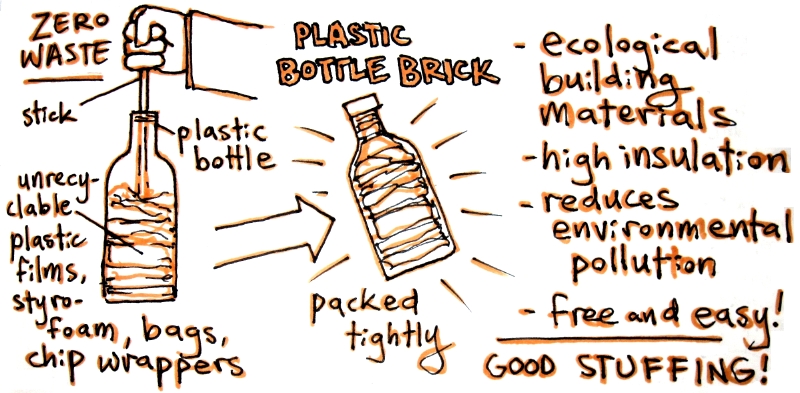Eco-Bricks
 The Collins’ Dictionary Word of the Year for 2018 was ‘single-use’. Collins’ defines single-use as: made to be used once only, e.g. single-use plastic bags. Many people think that most plastic is recyclable, but most councils only recycle plastic bottles and don’t accept other plastics, like ready meal trays or crisp packets. Since 1950, the world has produced as much plastic as the weight of 1 billion elephants, but just 9% of this has been recycled.
The Collins’ Dictionary Word of the Year for 2018 was ‘single-use’. Collins’ defines single-use as: made to be used once only, e.g. single-use plastic bags. Many people think that most plastic is recyclable, but most councils only recycle plastic bottles and don’t accept other plastics, like ready meal trays or crisp packets. Since 1950, the world has produced as much plastic as the weight of 1 billion elephants, but just 9% of this has been recycled.
There are 5.25 trillion pieces of rubbish in the ocean, and counting. 70% of that rubbish is plastic, with the rest being metal and glass. Fish and other sea animals can ingest large pieces of plastic that clog their intestines or can become entangled in plastic and suffocate. The pieces of plastic that fish ingest are then ingested by humans when we eat the fish. Recent studies found that seafood eaters ingest up to 11,000 pieces of plastic each year, but researchers predicted that this number could turn into 780,000 by the end of the century.
There are three main ways plastics end up in our oceans.
- Litter that is dropped on the streets or left on the beaches can blow into a nearby water source or down the drains.
- Microbeads, which are beads of plastic smaller than a piece of sand, are added to beauty products such as face scrubs and toothpaste and go down the drain, as they are too small to be filtered out of water.
- Plastic from the mounds of rubbish in landfill sites can blow away and end up in the oceans.
The more plastic that is produced, the more plastic ends up in our oceans and damages our environment. However, there is a community of people who have found a solution. Their aim is to reduce the amount of unnecessary plastic packaging entering the ecosystem, and they have found an environmentally friendly way to use the plastic we have now - the eco-brick. An eco-brick is a plastic bottle filled with single-use plastic to create a building block that is reusable. If they are built sturdily and to the right weight, they can be used to build anything from garden furniture to houses.
To make an eco-brick you use a clean, dry plastic bottle and stuff this with clean, dry, single-use plastic. This can be anything including sweet wrappers, crisp packets and bags used to package fruit and vegetables at the supermarket. The eco-brick community have lots of information online explaining the bricking process.
There are also organisations such as Greenpeace who are campaigning for supermarkets to eradicate the use of unnecessary single-use plastic and many supermarkets have made pledges to reduce the amount of plastic packaging that they use in their products. Eco-bricking would stop the oceans from being contaminated and would overall, make the world a better place to live.

(1).png)
.png)
.jpg)


